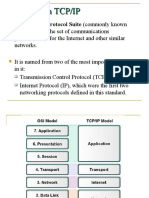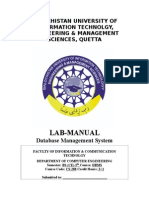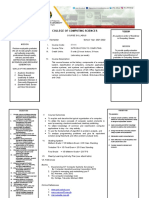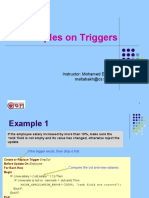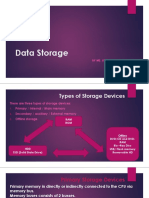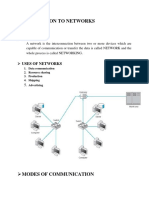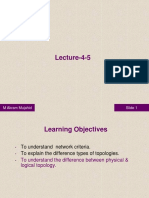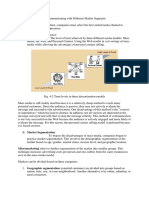Data Communications
ISO/OSI Model
OSI/ISO Seven Layers Model
To address the problem of networks being
incompatible and unable to communicate with
each other, the International Organization for
Standardization (ISO) researched network
schemes like TCP/IP in order to find a set of rules.
As a result of this research, the ISO created a
network model that would help vendors create
networks that would be compatible with, and
operate with, other networks.
Rather than developing protocols, they identified
which networking functions had related uses and
collected those functions into discrete groups that
became the layer
The OSI reference model
The OSI reference model, released in 1984,
was the descriptive scheme they created. It
provided vendors with a set of standards that
ensured greater compatibility and
interoperability between the various types of
network technologies that were produced by
the many companies around the world.
In the OSI reference model, there are seven
numbered layers, each of which illustrates a
particular network function. This separation of
networking functions is called layering.
Each layer defines a family of functions
distinct from those of the other layers
Advantage of seven layers model
Dividing the network into these seven layers
provides the following advantages:
It standardizes network components to allow
multiple-vendor development and support.
It allows different types of network hardware
and software to communicate with each other.
It prevents changes in one layer from affecting
the other layers, so that they can develop
more quickly.
It breaks network communication into smaller
simpler parts to make learning it easier to
understand.
Encapsulation
The data portion of a packet at layer (n-1) carries
whole packet (including data and headers) from
layer n
A packet at layer 7 is encapsulated in a packet at
layer 6, the whole packet of layer 6 is encapsulated
into a packet at layer 5 and so on
Application layer
The application layer is responsible for
providing services to the user.
Layer 7: The Application Layer
It provides network services to the user’s
applications.
It differs from the other layers in that it does
not provide services to any other OSI layer,
but rather, only to applications outside the
OSI model.
Example browsers (http protocol), e-mail
client like outlook express (pop3 protocol,
smtp protocol), file transfer (ftp protocol),
remote access (telnet) and NFS etc.
Layer 7: The Application Layer
Remote login
ftp
Mail services
Presentation layer
The presentation layer is responsible
for translation, compression, and
encryption.
Layer 6: The Presentation Layer
The presentation layer ensures that the
information that the application layer of one
system sends out is readable by the
application layer of another system.
If necessary, the presentation layer translates
between multiple data formats by using a
common format.
If you want to think of Layer 6 in as few words
as possible, think of a common data format.
Provides platform independence
Layer 6: The Presentation Layer
Code Conversion
ASCII to EBCDIC
Encryption
For
secure messages encryption at sender
end and decryption at recipient end
Compression
To improve performance by reducing size
of the message.
Session layer
The session layer is responsible for dialog
control and synchronization
Layer 5: The Session Layer
As its name implies, the session layer establishes,
manages, and terminates sessions between two
communicating hosts.
The session layer provides its services to the
presentation layer.
It also synchronizes dialogue between the two
hosts' presentation layers and manages their data
exchange.
In addition to session regulation, the session layer
offers provisions for efficient data transfer, class of
service, and exception reporting of session layer,
presentation layer, and application layer problems.
Layer 5: The Session Layer
Dialog control
It allows communication between two processes
to take place
Synchronization
Allows a process to add check points or
synchronization points e.g. if transferring a file of
1000 pages, a checpoint may be inserted after
every 10 page unit to ensure received
acknowledgement
In case of disconnection, the transferred pages
should not be re-transmitted.
Layer 4: The Transport Layer
The transport layer segments data from the sending
host's system and reassembles the data into a data
stream on the receiving host's system. The
boundary between the session layer and the
transport layer
Whereas the application, presentation, and session
layers are concerned with application issues, the
lower three layers are concerned with data transport
issues
The transport layer attempts to provide a data
transport service that shields the upper layers from
transport implementation details.
Source-to-destination delivery
Transport layer
The transport layer is responsible for the
delivery of a message from one process to
another
Reliable process-to-process delivery of a message
Layer 4: The Transport Layer
Specifically, issues such as how reliable transport
between two hosts is accomplished is the concern
of the transport layer.
In providing communication service, the transport
layer establishes, maintains, and properly
terminates virtual circuits.
In providing reliable service, transport error
detection-and-recovery and information flow
control are used.
If you want to remember Layer 4 in as few words
as possible, think of quality of service, and
reliability.
Layer 4: The Transport Layer
Program Addressing
Segmentation and Reassembly
Connection control
Connection oriented transport protocol establishes
connection with the recipient machine’s transport
layer before exchange of message
Flow control
Flow control is performed end-to-end rather than
across a single link
Error control
Error control from process to process rather than
across a single link
Hop-to-hop delivery
The network layer is responsible for the
delivery of individual packets from
the source host to the destination host.
Network layer
Layer 3: The Network Layer
The network layer is a complex layer that provides
connectivity and path selection between two host
systems that may be located on geographically
separated networks.
If you want to remember Layer 3 in as few words as
possible, think of path selection, routing, and
addressing.
Logical Addressing
Physical addresses can be used for data
transmission within the same network and if a packet
passes boundaries of the network, then we need
another addressing scheme
Routing
In internetwork routers are used to route packets
from source to destination
Data link layer
The data link layer is responsible for moving
frames from one hop (node) to the next.
Layer 2: The Data Link Layer
The data link layer provides reliable transit of
data across a physical link.
In so doing, the data link layer is concerned
with physical (as opposed to logical)
addressing, network access, error
notification, ordered delivery of frames, and
flow control.
If you want to remember Layer 2 in as few
words as possible, think of frames and media
access control.
Layer 2: The Data Link Layer
Framing
Converts network layer packets into frame
Physical Addressing
Flow Control
Sender and receiver should communicate at mutually
accepted data rate
Error Control
Error detection mechanism
Access Control
When two or more devices are connected to the same
link, then which device should have control over
shared medium
Layer 1: The Physical Layer
The physical layer defines the electrical,
mechanical, procedural, and functional
specifications for activating, maintaining, and
deactivating the physical link between end
systems.
Such characteristics as voltage levels, timing of
voltage changes, physical data rates, maximum
transmission distances, physical connectors, and
other, similar, attributes are defined by physical
layer specifications.
If you want to remember Layer 1 in as few words
as possible, think of signals and media.
Physical Layer
Physical characteristics of medium
Representation of bits
Data rate
Synchronization of bits
Line configuration
Connection of devices to the media – point to point
(dedicated) or multipoint – shared
Physical topology
Transmission mode
Simplex
Half duplex
Full duplex
Physical layer
The physical layer is responsible for
Movements of individual bits from one hop
(node) to the next.
Summary of layers
2-4 TCP/IP PROTOCOL SUITE
The layers in the TCP/IP protocol suite do not
exactly match those in the OSI model. The original
TCP/IP protocol suite was defined as having four
layers: host-to-network, internet, transport, and
application. However, when TCP/IP is compared to
OSI, we can say that the TCP/IP protocol suite is
made of five layers: physical, data link, network,
transport, and application.
Topics discussed in this section:
Physical and Data Link Layers
Network Layer
Transport Layer
Application Layer
TCP/IP and OSI model
2-5 ADDRESSING
Four levels of addresses are used in an internet employing
the TCP/IP protocols: physical, logical, port, and specific.
Topics discussed in this section:
Physical Addresses
Logical Addresses
Port Addresses
Specific Addresses
Addresses in TCP/IP
Relationship of layers and addresses in TCP/IP
Example 2.1
In Figure 2.19 a node with physical address 10 sends
a frame to a node with physical address 87. The two
nodes are connected by a link (bus topology LAN). As
the figure shows, the computer with physical address
10 is the sender, and the computer with physical
address 87 is the receiver.
Physical addresses
Example 2.2
As we will see in Chapter 13, most local-area networks
use a 48-bit (6-byte) physical address written as 12
hexadecimal digits; every byte (2 hexadecimal digits) is
separated by a colon, as shown below:
07:01:02:01:2C:4B
A 6-byte (12 hexadecimal digits) physical address.
Example 2.3
Figure 2.20 shows a part of an internet with two routers
connecting three LANs. Each device (computer or
router) has a pair of addresses (logical and physical) for
each connection. In this case, each computer is
connected to only one link and therefore has only one
pair of addresses. Each router, however, is connected to
three networks (only two are shown in the figure). So
each router has three pairs of addresses, one for each
connection.
IP addresses
Example 2.4
Figure 2.21 shows two computers communicating via the
Internet. The sending computer is running three
processes at this time with port addresses a, b, and c. The
receiving computer is running two processes at this time
with port addresses j and k. Process a in the sending
computer needs to communicate with process j in the
receiving computer. Note that although physical
addresses change from hop to hop, logical and port
addresses remain the same from the source to
destination.
Port addresses
Note
The physical addresses will change from hop to hop,
but the logical addresses usually remain the same.
Example 2.5
As we will see in Chapter 23, a port address is a 16-bit
address represented by one decimal number as shown.
753
A 16-bit port address represented
as one single number.
Note
The physical addresses change from hop to hop,
but the logical and port addresses usually remain the same.


















